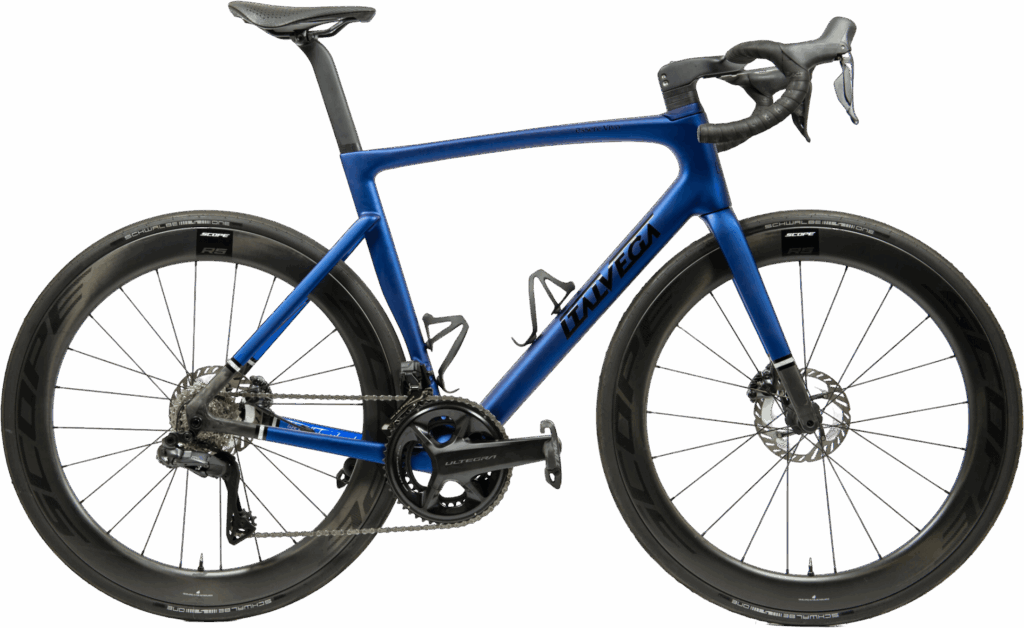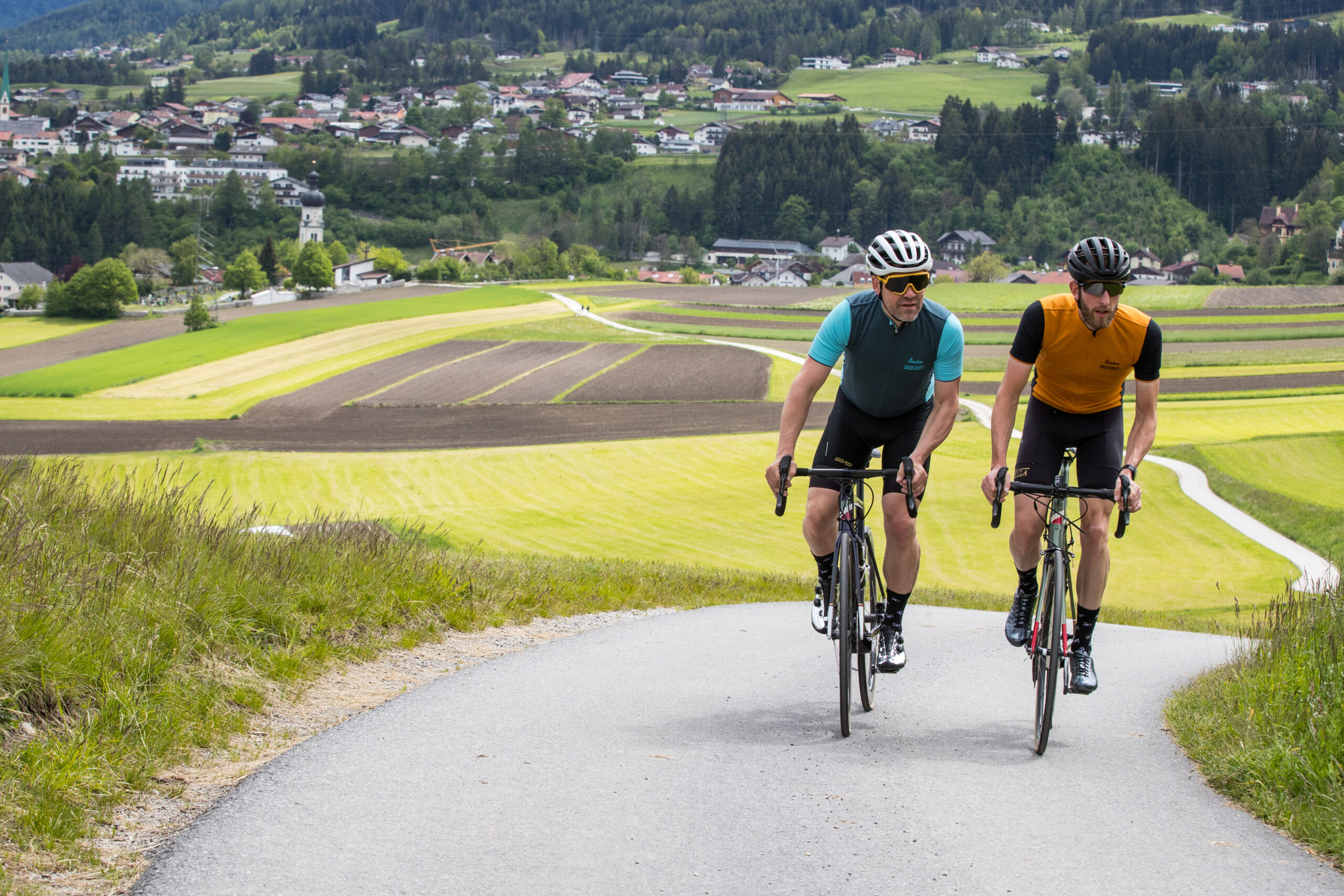Italvega: it sounds Italian, but nothing could be further from the truth. Léon van Bon took this stylish aero racehorse to Austria and France for tough testing and summer fun in the Alps. After all, you only live once, right?
Italvega Essere Vivo
The ooohs and aaahs are flying around me. “It must be Italian with that name and Campa on it.” “I don’t know the brand…” says another Dutchman. I’m having lunch on the terrace of the La Douce Montagne bike hotel, near Alpe d’Huez. This Italvega is clearly to everyone’s taste. In a few days, it will be Alpe d’HuZes, so the place is teeming with Dutch people who, as a former professional cyclist and/or bike tester, are keen to talk to me and, if possible, get a preview of the next test article. The Italvega Essere Vivo is indeed a very nice bike, but it doesn’t have Italian roots. Although…
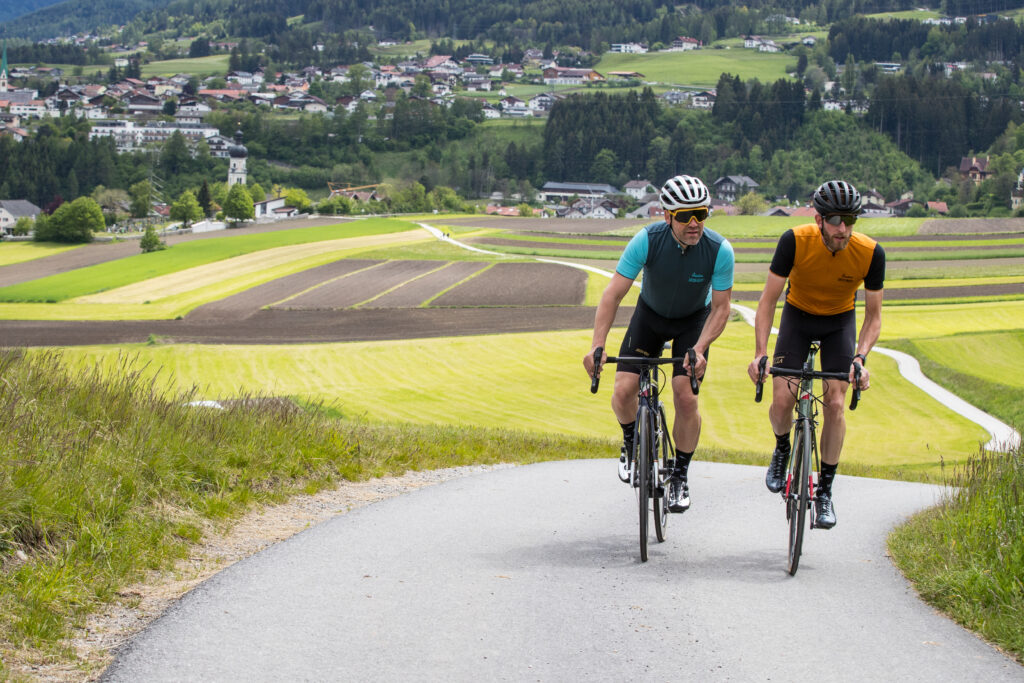
Open mold
Ben Lawee, an Iraqi, had a bicycle shop in California, where he imported Bianchi and Raleigh, among other brands. In the early 1970s, he founded his brand, Italvega. The frames were built in Padua, Italy, then transported to America. At the end of the 1970s, Lawee stopped with Italvega and started Univega. Italvega did not exist from the 1970s until 2017, when Dutchman Nicholas Hurenkamp from Alphen aan den Rijn breathed new life into it. He was tired of his titanium bike and wanted something new and unique. Hurenkamp has a background in the fashion world, so it had to look sleek and exude class—a brand where cycling and enjoyment are paramount. The logo was revamped, and the original green color was used as the basis.
This Essere Vivo is the third type of frame from the Italvega stable. Like the other two, it is an open mold frame. These frames are sold unpainted and can be used by different brands. Ridley, for example, manufactures such frames, which you will often see with a different name. This means, of course, that you have a high-quality frame and therefore an excellent bike. Italvega has secured the exclusive rights to this Essere Vivo in the Benelux, so it does not come from Ridley. Just that little bit more exclusive than most open moulds.
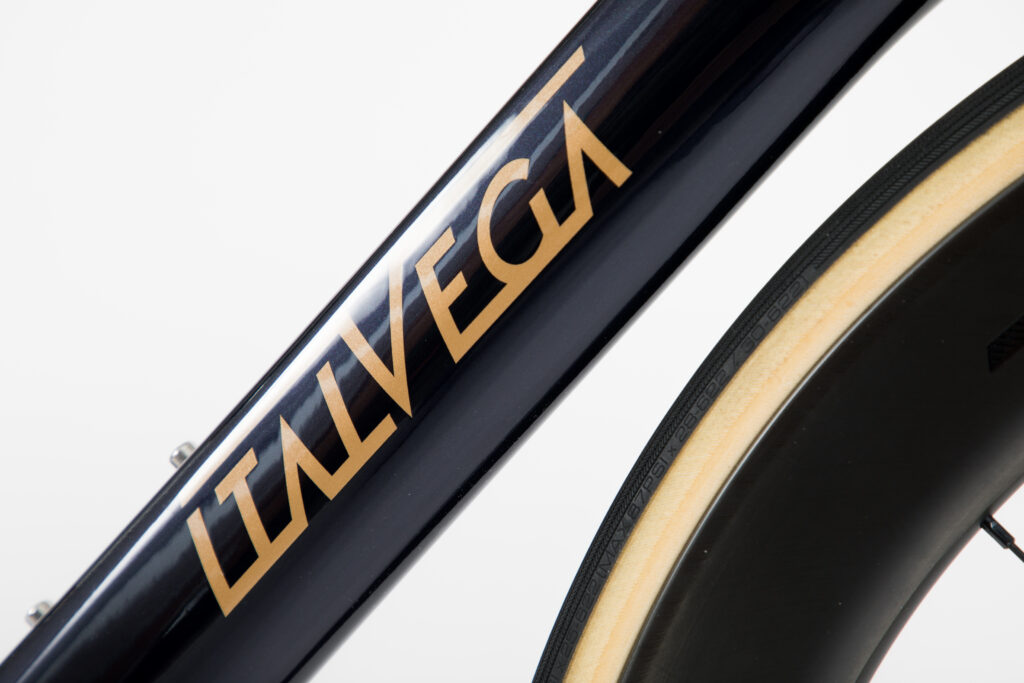
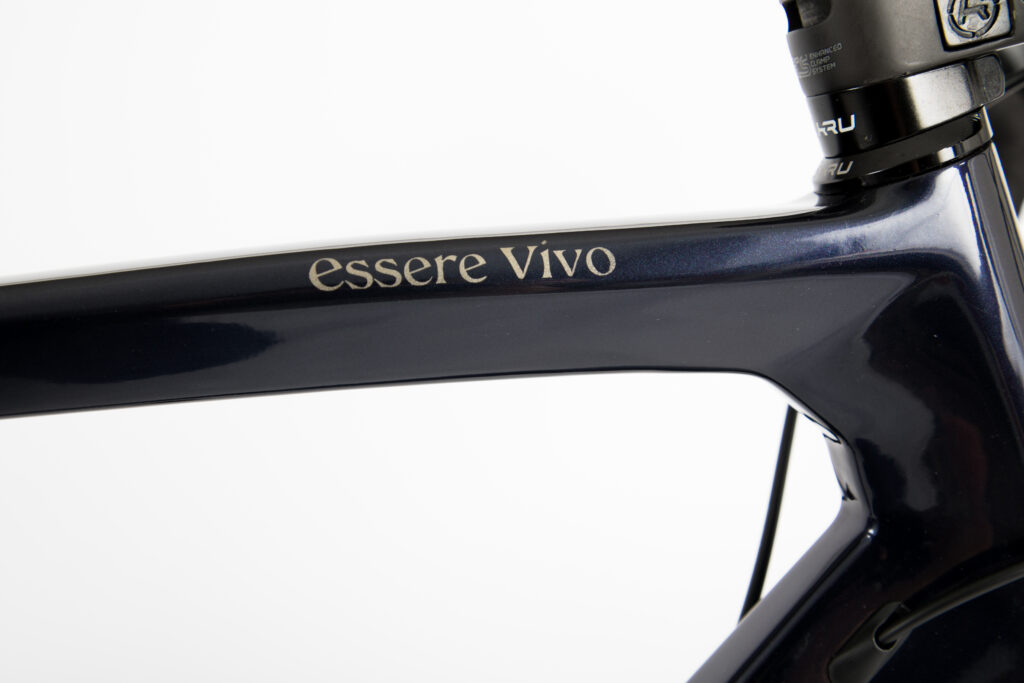
Italvega drapes a beautiful sauce over the frame, turning it into a stunning bike. The paintwork looks sleek, and the logo has been sprayed on too, showcasing top-notch craftsmanship. You also have a wide choice of colors, all of which have been carefully selected to complement each other perfectly.
Specifications:
– Price: €3,199 for frame, fork, handlebars, seat post
– Frame/front fork: carbon/carbon
– Weight: 1120/420 grams, 8.05 kg complete
– Group: Campagnolo Record 12-speed, 52/36, 11/28, 160 mm
– Wheels: Scope R5 Disc
– Tires: Vittoria Corsa Control 25 mm
– Saddle and seat post: Fi’zi:k Arione/Italvega
– Handlebar and stem: Kru K-Class Super Compact cockpit
– Sizes: XS to XL
– Torsional stiffness: 99
– Bracket stiffness: 50
Website: www.italvega.com
Aero
It is a true aero frame, yet accessible to many thanks to the length of the head tube. It is long enough to allow for a comfortable aero position, yet short enough to look sleek and fast. The shape of the tubes is typical for aero frames, as is the low position of the chainstays. It all looks great. The matching oval seat post is neatly secured by a clamp concealed with a rubber plate. The cables run neatly inside. The Kru aero handlebar with integrated stem also looks neat. A lot of attention has been paid to detail. The handlebar is partially finished in the color of the frame with a gold V from ItalVega on it.
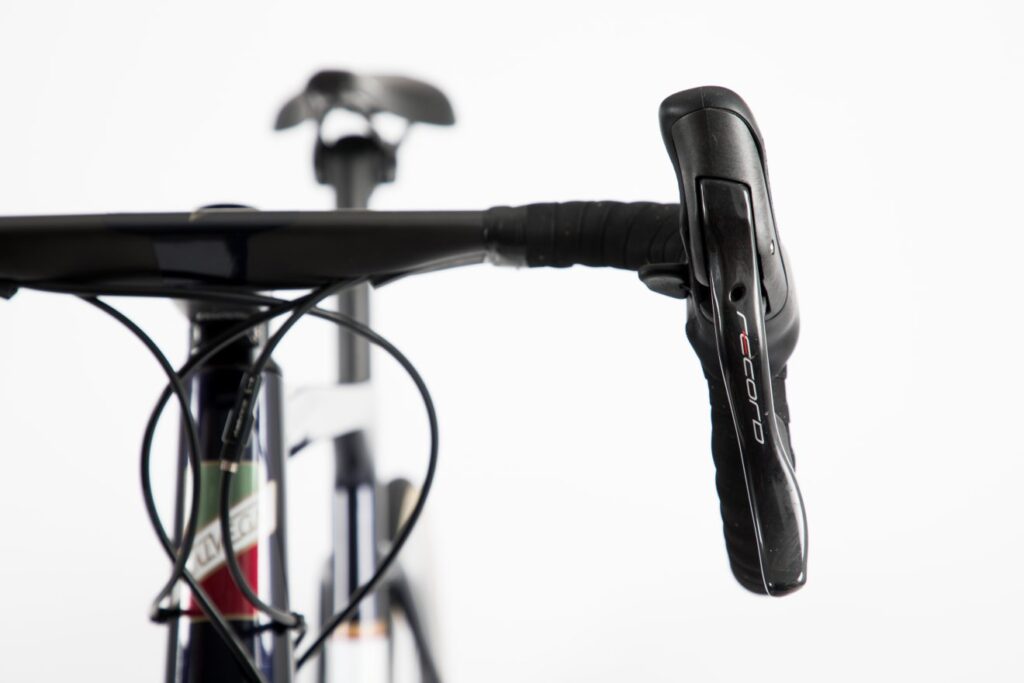
The mechanical Campagnolo Record group with hydraulic disc brakes looks excellent and gives the whole bike an even more Italian feel. The Campa discs are still a feast for the eyes. Elegant and refined. The Scope wheels complete the look. A set of thick wheels gives the bike extra punch. The stickers on the wheels are sprayed in the same blue as the bike, but you can hardly see them because they are almost black. Those wheels look great, with wide rims and a beautiful Scope hub. The Vittoria Corsas with yellow sidewalls give the bike a classic touch. The paintwork does the same, and this enhances it beautifully.
Points of criticism
It’s a beautiful bike, that’s clear. Still, I have a few comments. The thru-axles used are not exactly chic, and I would have preferred them with an Allen key. Of course, this is a matter of taste and has more to do with appearance than ease of use.
Still, I think the Allen key version is more suited to an aero bike. I also find it a shame that the quick-release protrudes on the side where the thread is. It doesn’t look as sleek as the rest. Another minor criticism is the white color of the axles. This is the place that gets dirty quickly, especially with disc brakes. What’s more, it’s more prone to damage. If you put your bike on the front fork or the rear wheel and it doesn’t go in properly, you’ll quickly get a scratch, which is very noticeable. The paint wasn’t very strong anyway, but that was due to the short time between spraying and delivery. Usually
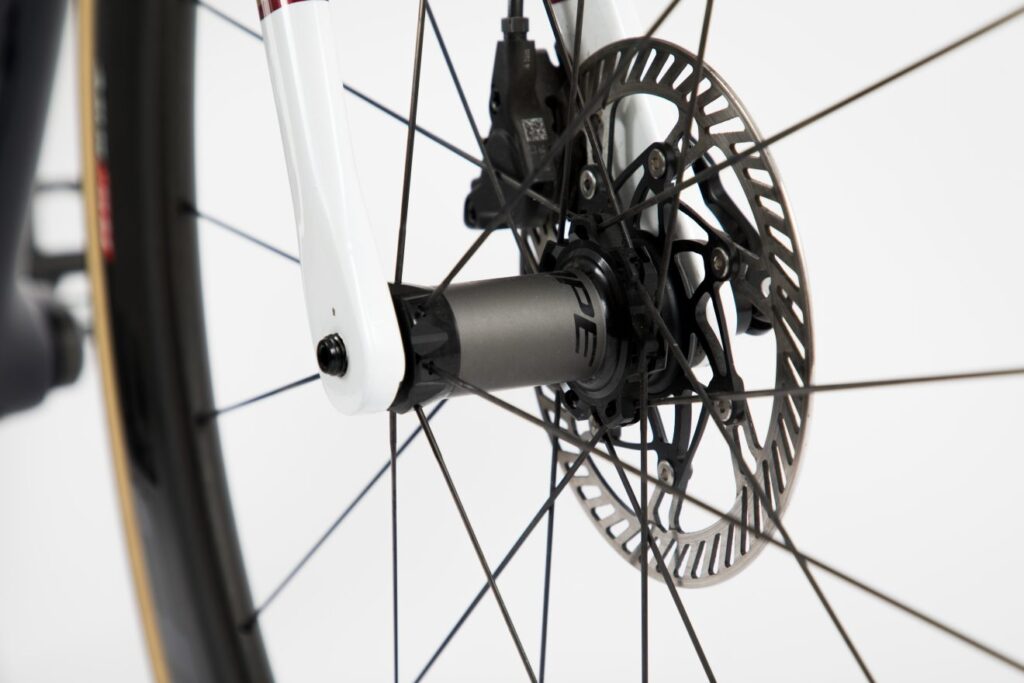
On the road with the Italvega
In recent weeks, I’ve traveled a lot in the Netherlands, Austria, and France, and I always took the Italvega with me. In the Netherlands, I took my usual rides and attended an event. In Austria, I explored the roads around Innsbruck, and in France, I was near Alpe d’Huez.
One of my first trips on the Italvega was a cycling event with architects. It was a fun gathering with a dozen former professional cyclists and 120 architects or associates. The bike attracted a lot of interest here and was greatly appreciated for its appearance. And architects should have an eye for stylish things, after all. Even the former pros looked at my bike with some envy.
The first few meters on a new bike often give a good impression. The bike feels sleek and solid. When I start pedaling, it feels good. Every pedal stroke is on point, and the bike clearly wants to move forward. It’s not a comfort bike, but more of a racer. It’s not very responsive, but mainly wants to move forward, which is something you often encounter with aero bikes.
I was only in Austria for a short time. I did one nice ride on the Italvega, which was mainly focused on enjoying the surroundings. The action photos are from there.
Descending like a bullet
It’s now a few days later, and I’ve arrived in the Alps. That’s not exactly the ideal habitat for this aero racer. At 8.3 kilos including pedals, it’s not a lightweight, and I even find it on the heavy side for a bike in this category. I’m not at my ideal weight, so I shouldn’t be too critical of my bike. Today, the Col du Solude and the Alpe d’Huez via Villard Reculas are on the menu. We start in Huez, so we dive straight down. Lovely. It’s busy, so that means no crazy stuff. I’m riding with Jelle, who rides a bit more cautiously. The descent is fast; before you know it, you’re riding at 70 kilometers per hour. You must brake hard regularly to get through the 21 hairpin bends.
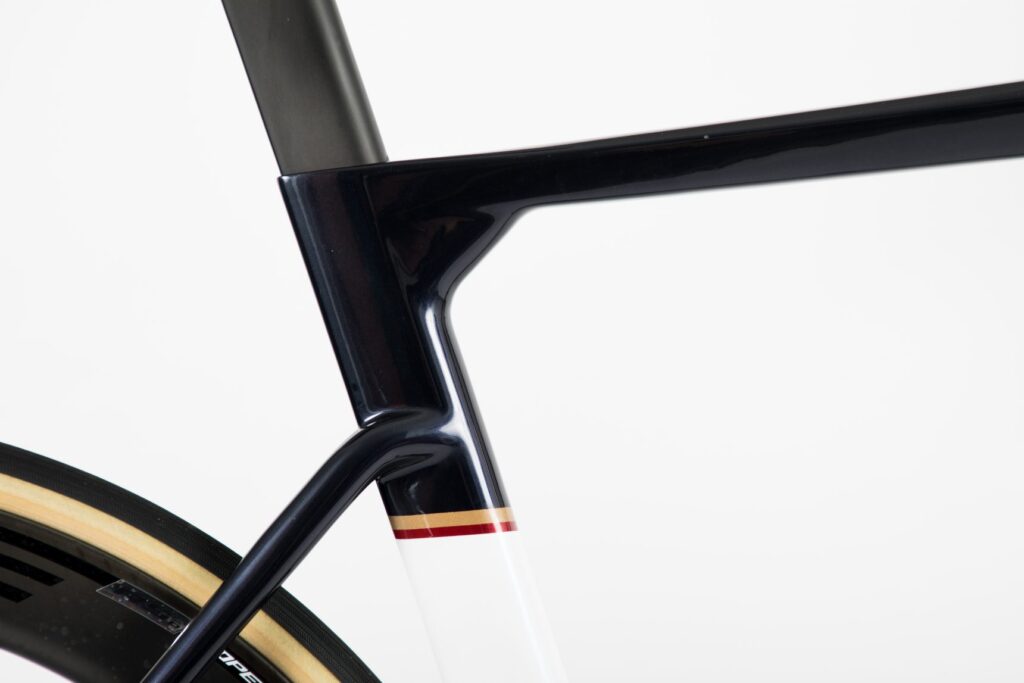

The Campa discs brake well. However, I feel the bike pulls slightly to the left when I brake hard at high speeds. My tight feeling on flat terrain is also much less noticeable when I dive downhill. The disc brakes also allow you to brake a little later, naturally putting more force on the frame and wheels. Without wanting to brag, I descend a lot faster than the average cyclist. “You descend like a bullet,” says Jelle. We turn onto the first climb. We stay together until the last tunnel because they are dark and not lit. It’s pretty scary. Jelle’s light wasn’t working correctly, so we had to guess where we were going. What an incredible climb this is. I know the Alps mainly from the Tour de France, where you usually stay on the main roads. This little road is entirely different. It’s narrow, and the valley is right next to you. The precipice is steep and quite scary at times, but above all, it’s stunning. ‘Life is all about the ride’ is written on the rear fork. I find that quite a statement, but I understand it very well at the moment. Just like ‘Essere Vivo’, which is difficult to translate, it
Sticking disc brake
I’m glad I’m here and made some time in my busy schedule to ride here. The bike climbs perfectly. When I’m almost at the top, the disc brake starts to stick slightly. Out of nowhere, it seems. When I stand on the pedals, it disappears again. This will happen a few more times later in the day. It’s not a disaster, but when you’re struggling, it can be unpleasant. I approach the top, where Jelle has been waiting for me for quite some time. Follow a few kilometers of bad road, then a gravel path to the next top. It’s not much of a climb because you stay at about the same altitude. You can also feel the sensation of a deep ravine right next to the road. We start the descent. It’s a technical drop, and I throw myself through the turns. Of course, I do so responsibly and consider any other traffic. I also enjoy myself. It’s very quiet on this road. The feeling that the bike pulls to the left when I brake hard remains. Occasionally, I also have trouble holding the corner, and the bike breaks out a little, but overall, the Italvega gets a nice passing grade for its descending capabilities.
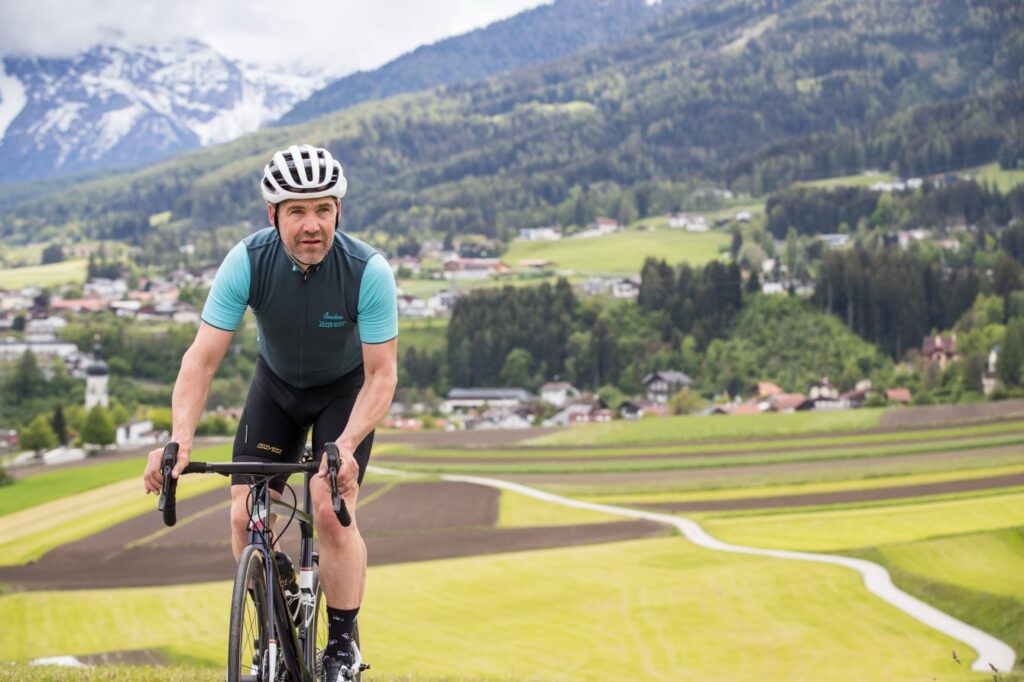
We ride to the terrace of La Douce Montagne. Along the river on the bike path, we cruise easily at 35 kilometers per hour, with a breeze at our backs and a slight downhill slope. The Italvega clearly feels at home here. I steer easily through the bends and feel confident. Just push off and accelerate. It’s great. I park my bike, and while I’m eating, people keep gathering around the supposed Italian. I only hear positive comments.
Not a dozen of them
After lunch, we tackle another climb. I tell Jelle to keep going because the gap is too big. Half an hour later, I’m still riding alone, and I’m exhausted. I’m glad there’s no one around me—time for a rest. I think back to my meeting with Nicholas, the founder of Italvega. The brand should exude class, camaraderie, and enjoyment. Yeah, right, I’m riding alone and exhausted, I say to myself. I have to laugh: Essere Vivo, but I’m alive.
The Italvega clearly has the looks. Whether it’s your taste is up to you, of course. Nicholas has an eye for taste and style, reflected in these bikes. Impressive, considering it’s a small brand. The bike, as tested, costs €6,799. Of course, it has high-end components that justify the hefty price tag, but you do get a striking bike that rides wonderfully. It’s not one of a dozen, even though it’s an open mold. I’m very curious to see where this brand is going and how it will develop. In any case, the Essere Vivo is a step in the right direction.
Our ratings:
Image: 6.5
Quality: 8.0
Price/quality: 7.0
Measurements: 7.8
Practicality: 8.2
– Total: 7.7

